Case Report - (2022) Volume 11, Issue 3
Surgical management of gynecomastia, the benign enlargement of the male breast (usually bilateral but sometimes unilateral) resulting from a proliferation of the glandular and fatty tissues component of the breast has been reported over the years. However, there has been a dearth of information on the surgical management of Gynaecomastia from an African author. The author thus aims to share his experiences in the last five years (2017 -2021) including techniques, outcomes and complications. A review of all gynaecomastia patients operated in the author’s private clinic in Nigeria over a 5-year period was undertaken in this study. For the purpose of the study, each operated breast was considered as an individual case. In total, 76 breasts in 38 patients were treated. The procedure was carried out either under local or general anaesthesia. Liposuction was first carried out to remove fat under the breast tissue followed by excision of breast tissue with a cut made around the areola to access the breast tissue. The cut is subsequently closed with vicryl 3/0 suture, after which a compression vest is worn for a period of 6 weeks to prevent fluids or blood products from accumulating under breast area. Trends observed with the average age, weight of breast tissue excised, weight of patients, duration of surgery, patients’ satisfaction, complications are reported. The mean age of patient presented for the procedure was 32 years, mean weight of patient was 95.9 kg, the mean weight of breast tissue excised was 355 g. Number of gynaecomastia surgeries carried out increased progressively over the years with 11% of the procedures done in 2017, 19% in 2018, 17% in 2019 and 53% in 2021 showing the popularity this procedure has gained in Nigeria over the years. No mortality was recorded from this procedure; however, complications including Pain, skin necrosis, itching, infection, bleeding, bruising, keloid, hypertrophic scars were observed. 94% of patients were satisfied with their cosmetic outcome as only about 6% of the patients were back for a review. Gynaecomastia surgery has gained more awareness in Nigeria over the years with more exposure noted about the procedure.
Gynaecomastia • Africans • Gynaecomastia surgery • Breast surgery in men
Gynaecomastia is the most common benign breast condition in men characterized by an enlargement of the male breast which is attributable to proliferation of the glandular tissue and local fat deposition. Even though it is usually benign, it causes much anxiety, psychosocial discomfort as it could have an impact on self-confidence and body image and also fear of breast cancer [1,3]. Gynecomastia can be unilateral (affecting one breast) or bilateral (affecting both breasts), sometimes unevenly affecting both breasts unevenly. Male breast tissue proliferation can occur at all ages. It has been estimated that 30% to 60% of boys exhibit gynecomastia during adolescence and that at least one third of the adult male population may be affected [1]. Gynecomastia has been reported to have three peaks of occurrence during the life span: (a) The neonatal period where an estimated 60% to 90% of infants have transient gynecomastia due to transplacental transfer of maternal estrogens which usually regresses completely by the end of the first year; (b) Puberty, where Gynecomastia occur in 48% to 64% of boys at puberty. It may first appear as early as 10 years of age, with a peak ages 50 to 80 [2,3]. Gynecomastia is often asymptomatic and may be an incidental finding on routine examination. It is to be differentiated from Pseudogynecomastia (fatty breasts) which is common in obese men. In true gynecomastia, there may be a knob of firm subareolar tissue, or there may be a more diffuse collection of fibroglandular tissue that resembles that of the female breast, and which may be difficult to distinguish from simple adiposity. Comparing the subareolar tissue with the anterior axillary fold or other subcutaneous tissue may help in differentiating true gynecomastia from pseudogynecomastia [4]. Most gynecomastia is caused by an imbalance of estrogens, that stimulate breast tissue growth over androgens, that inhibit breast tissue growth [5,6]. Other factors may include: Renal failure and dialysis, Cirrhosis of the liver, Hyperthyroidism, Drugs and medications
Treatment of gynecomastia may include: drugs treatment, radiation and surgery. Surgical treatment may be more appropriate when gynecomastia has been present for more than two years and medical therapy has become ineffective especially when trials of medical therapy has been ongoing for 6 months [7]. Surgical management of gynecomastia has been reported over the years. However, there has been a dearth of information on the surgical management of Gynaecomastia from an African author. The author thus aims to share his experiences with gynecomastia surgery in Nigeria in the last five years (2017-2021) including techniques, outcomes and complications.
Surgical Technique
All causes of gynecomastia share an imbalance of estrogens and androgens with a decreased testosterone-to-estradiol ratio that directly affects the breast tissue [8]. The clinical appearance of Gynecomastia is developed from an altered ratios of androgens and estrogens or the increased sensitivity of breast tissue to normal circulating estrogen levels that gives rise to ductal hyperplasia, elongation and branching of the ducts correlated with proliferation of fibroblasts and neovascularization [9,10]
Amongst the various classifications of gynecomastia (Figures 1 and the classification by Simon et al., [11] based on hypertrophic skin, is most often used: 2),
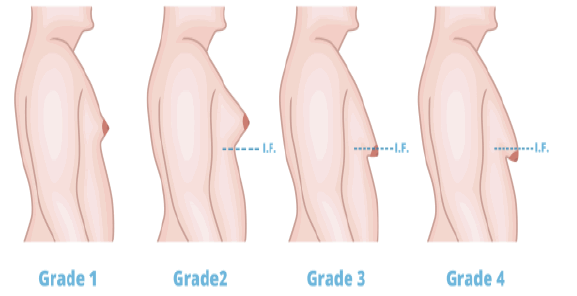
Figure 1: Grades of Gynecomastia (Source: The New You).
a. Grade I. Small breasts without hypertrophic skin.
b. Grade II. Moderate breasts without hypertrophic skin.
c. Grade III. Moderate breasts with hypertrophic skin.
d. Grade IV. Large breasts with hypertrophic skin, similar to female breasts
A review of all gynaecomastia patients (Grade I-IV) operated in a private clinic in Nigeria over a 5-year period (2017-2021) was undertaken in this study. For the purpose of the study, each operated breast was considered as an individual case. In total, 76 breasts in 38 patients were treated. Their ages ranged from 18 years to 53 years with body weight ranging from 67.8 kg-143.1 kg. Approval from an institutional review board or ethics committee was not obtained as all patients underwent surgical procedures
in a private practice in Nigeria. However, the study was conducted in accordance with the Declaration of Helsinki principles. All patients were supplied with detailed information regarding the surgical procedure, and all patients provided written informed consent. Patients were analysed and diagnosed after clinical and laboratory examinations including liver enzymes, creatinine, potassium, sodium, calcium, thyroid-stimulating hormone, free triiodothyronine, luteinizing hormone/follicle-stimulating hormone ratio, testosterone, estradiol, sexual hormone-binding globulins, prolactin, Human Choriongonadotropin β Subunit (βHCG)) were carried out and mammary ultrasound. Preoperative markings were done in vertical position after photographic documentation. They then underwent surgery after the diagnosis of gynecomastia was confirmed.
During consultation, it is important that a good history is taken from the patient and should include asking if patient smoke regularly, this information is needed as patients are advice to avoid the habit for at least a period of 21 days before the surgical procedure. Smoking increases the tendency for bleeding to occur and prolongs healing time. It mostly increases the likelihood of complication from the procedure. Patients are confirmed if on medications especially antihypertensive or anti-diabetic drugs and advised on the best way of usage as patients are usually advised to abstain from food, water or any kind of drink for at least 6hours-8hours before the procedure. The risks of the procedure are clearly explained to the patient which might include scarring, pain, redness, swelling, bruising, darkening of the skin, numbness around the liposuction area, skin loss
Surgical technique
Surgical technique Liposuction in addition to the removal of breast tissue is done during the gynecomastia surgery. The surgery can be carried out either under local or general anaesthesia (Figures 2,3).
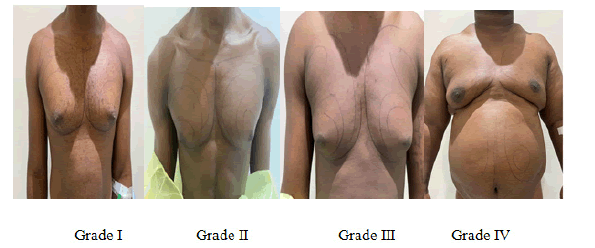
Figure 2: Pictures showing Grades I-IV gynecomastia
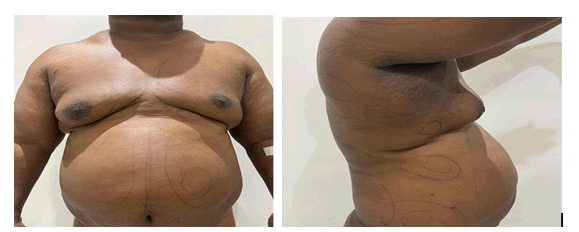
Figure 3: Front and Side View of a Gynecomastia Patient.
The subcutaneous fatty tissue of the breast was infiltrated with Standard Tumescent Solution [12] containing adrenaline, lidocaine and normal saline mixed in a 50 mL syringe. Two stab incisions per side were made by scalpel in the inframammary fold, 1 at the medial and 1 at the lateral aspect of the inframammary fold. Liposuction was done to take care of fat under the breast tissue before a cut was made around the areola to access the breast tissue. During the liposuction, the gland was partially dissected from the pectoral fascia and the surrounding tissue. After liposuction, the residual gland was removed from the retroareolar area via periareolar incision (in the median third of the areolar circumference), while pulling the nipple-areolar complex ventrally with a doublehook retractor (Figure 4).
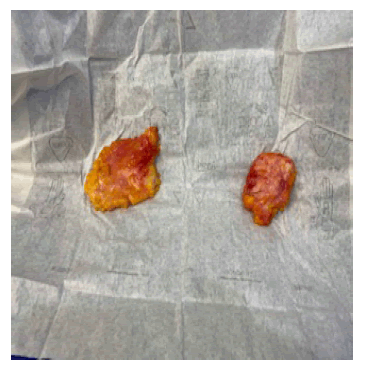
Figure 4: Excised skin
To minimize the wound cavity and the wound surface, 3–0 absorbable adaptive and subcuticular situative sutures were placed, followed by a running intradermal 4–0 absorbable suture. Sterile dressing was applied and moderate pressure was administrated to the thoracic wall by a non-wire, front-closure compression vest for approximately 4 weeks, which reduces hematoma and seroma formation to improve the aesthetic outcome.Patients are discharged 24 hours postoperatively. Follow-up visitations are on 4 days, 10 days and 14 days post surgery (Figure 5).
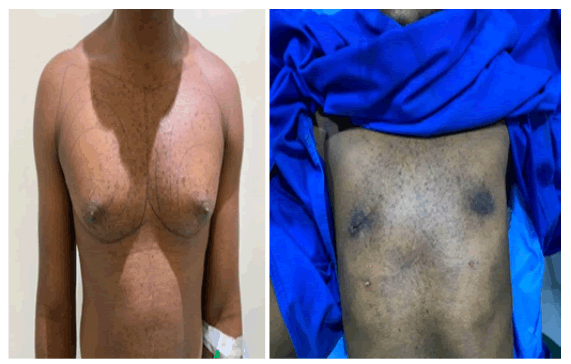
Figure 5: Before and after surgery picture of a gynecomastia patient.
A total of 76 breasts in 38 patients were analysed in this study. The mean age of patient presented for the gynecomastia procedure was 32 years (range:18 years to 53 years), mean weight of patient was 95.9 kg (range: 67.8 kg to 143.1 kg), the mean weight of breast tissue excised was 355g (range:150 g-600 g). The mean liposuction volume was 433 ml (range:180 ml-900 ml). The average volume of fluid used for infiltration of the skin was 1081.9 ml (range:240 ml-1,904 ml) and the average blood lost during the procedure was 271 (range:10 ml to 900 ml). 5 patients out of the 38 patients (13.2%) had a combined gynecomastia procedure with abdominoplasty
From the figure 6 below, 16.7% of the patients had body weight between 60 kg-80 kg, 58% were between 81 kg-100 kg, 8.3% had body weight between 101 kg-120 kg and 16.7% had their weights between 120 kg140 kg. 83% of the patients were overweight with body weight ranging from 81 kg-140 kg. We conclude that a higher percentage of gynecomastia The figure below describes the trend observed in the number of the procedure performed across the years (2017-2021). 4.2% of the procedures were performed in 2017, 8.3% in 2018, 18.6% in 2019, 25% in 2020 and 43% in 2021. The number of gynaecomastia surgeries carried out increased progressively over the years showing the popularity this procedure has gained in Africa over the years. More male patients have become more aware and acceptance of the possibility to have a more masculine chest in Africa (Figure 7)
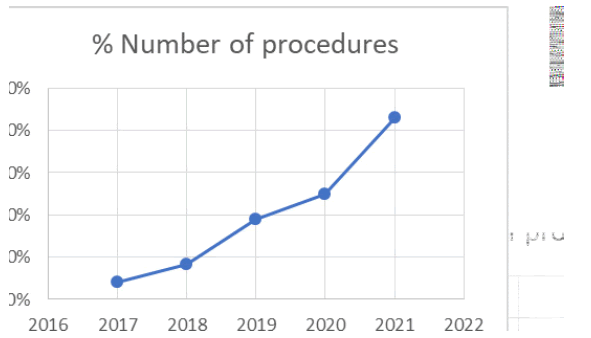
Figure 6: Describes the weight of patients for Gynecomastia
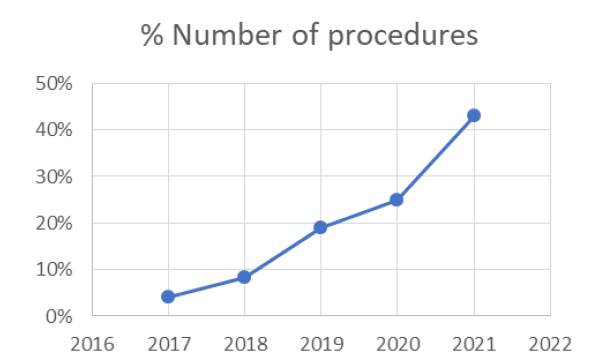
Figure 7: Describes the trend observed in the percentages number of gynecomastia procedure across the five years period.
From our results, mastectomy combined with liposuction gives a better aesthetics result and a lower complications rate. Thus, liposuction combined mastectomy should be encouraged. 94% of patients were satisfied with their cosmetic outcome as only about 6% of the patients were back for a review. The complications observed from this procedure however include: Pain, skin necrosis, itching, swelling, Infection, bleeding under the skin, anaesthesia or numbness, bruising, skin sagging, fibrosis usually under the skin, keloid, hypertrophic scars, hyperpigmentation, fat loss, pulmonary embolism, skin exfoliation, deep vein thrombosis, skin irregularities. No mortality was recorded from this procedure as at the data analysed.
Even though gynecomastia is usually benign, it causes much anxiety psychosocial discomfort as it could have an impact on self-confidence and body image and also fear of breast cancer. Drug treatment for the disease has been reported to be long lasting with a low success rate unlike the surgical treatment that is mostly straightforward [13]. An increased awareness of gynecomastia surgery has been noted even in Africa as with other parts of the world.
Citation: Oluwakemi T, Aranmolate RA. Gynaecomastia Surgery: The African Experience. Reconstr Surg Anaplastol, 2022, 11(3), 04-06.
Received: 28-Jun-2022, Manuscript No. ACR-22-18659 ; Editor assigned: 30-Jun-2022, Pre QC No. ACR-22-18659 (PQ); Reviewed: 07-Jul-2022, QC No. ACR-22-18659 (Q); Revised: 11-Jul-2022, Manuscript No. ACR-22-18659 (R); Published: 18-Jul-2022, DOI: doi.10.37532/22.11.3.4-6
Copyright: ©2022 Aranmolate R. A, et al. This is an open-access article distributed under the terms of the Creative Commons Attribution License, which permits unrestricted use, distribution, and reproduction in any medium, provided the original author and source are credited.